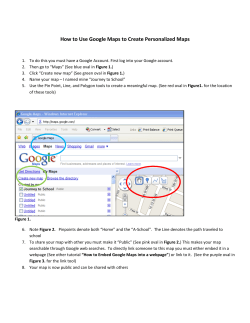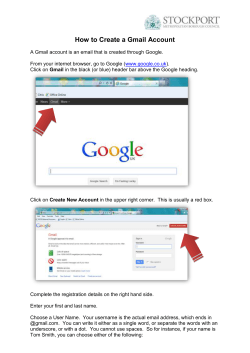
PR Seeks Economic Advice from NY Fed Offi cial PR Treasury to
16 The San Juan Daily Star January 23-25, 2015 PR Treasury to Temporarily Paralyze 2% Tax on Wire Transfers By EVA LLORENS VELEZ llorenseva4@gmail.com T he Puerto Rico Treasury Department is planning to temporarily paralyze the 2 percent tax collected on all wire transfers that went into effect in December following MoneyGram’s announcement that it was ending services in Puerto Rico because of the tax. US TREASURY DEPARTMENT PUBLIC AUCTION ** Friday, January 30 at 10AM ** 2 CONDOS IN SAN CRISTOBAL CONDOS, SAN JUAN Calle Sol No. 109, Apt. 1 - 2BR/2.5BA Calle Luna No. 311, Apt. 4B - 1BR/2BA OPEN: WED. 1/21 & SAT. 1/24 www.treas.gov/auctions/treasury/rp 703-273-7373 The announcement was made by Popular Democratic Party Rep. Carlos J. Vargas. He said the moratorium will give time to the businesses that handle wire transfers and money orders as well as the public to get used to the new tax and analyze its adequacy. He said Treasury Secretary Juan Zaragoza told him that he was going to issue an administrative order to temporarily paralyze the imposition of the new tax on all money transfers. The island government raised the tax last year to obtain more revenues for a housing program attached to the Puerto Rico Housing Finance Administration and to provide rental subsidies to the elderly. “I am available to listen to all those who want to express themselves,” Vargas said. “I will evaluate any alternative presented to deal with claims and see how we can adjust them to the new reality imposed by this legislation.” Last week, MoneyGram’s press officer, Michelle Buckalew, said in a statement that “MoneyGram remains committed to its operations in Puerto Rico and we continue to offer our convenient and reliable money transfer and bill payment services to and from the territory.” “However, due to a new 2 percent remittance transfer tax that went into effect last month, we have suspended money order services in Puerto Rico at this time,” she said. “MoneyGram is currently researching options and hopes to find a way to continue to provide this critical service to our customers in Puerto Rico. We apologize for any inconvenience this may cause our customers and our agents.” PR Seeks Economic Advice from NY Fed Official A vice president at the Federal Reserve Bank of New York has met with Puerto Rico senators to discuss how the commonwealth government can strengthen the island’s economy. James Orr says Puerto Rico should improve the performance of its state-owned corporations anda impose greater budgetary restrictions. He says the government also should create a capital expenditure budget, approve a tax reform and improve its financial transparency, among other things. The government said in a statement Thursday that Orr was invited as part of an ongoing push to meet with experts about how best to solve Puerto Rico’s economic problems. The island is in its eighth year of recession and has $73 billion in public debt. The San Juan Daily Star January 23-25, 2015 17 S&P to Pay Nearly $80 Million to Settle Fraud Cases By BEN PROTESS and MATTHEW GOLDSTEIN S tandard & Poor’s, the credit rating agency blamed for helping inflate the subprime mortgage bubble, has settled accusations that it orchestrated a similar fraud years after the bubble burst. S.&P. has agreed to settle an array of government investigations stemming from 2011, paying nearly $80 million and admitting some misdeeds, federal and state authorities announced on Wednesday. As part of the deals, reached with the Securities and Exchange Commission and the state attorneys general in New York and Massachusetts, S.&P. also agreed to take a one-year “timeout” from rating certain commercial mortgage investments at the heart of the case, an embarrassing blow to the rating agency. “This was egregious behavior with significant consequences,” Andrew J. Ceresney, the S.E.C.’s enforcement director, said on a conference call with reporters. He added that the problems pointed to a “deep cultural failure at S.&P.” and a “failure to learn the lessons of the financial crisis.” The settlement, which coincided with the filing of an S.E.C. action against a former S.&P. ratings executive, is the S.E.C.’s first action against a top ratings firm. Despite the central role that rating agencies played in the crisis — awarding inflated credit ratings to mortgage investments that spurred the debacle — they faced no S.E.C. penalties. Yet the Justice Department and several state attorneys general did take action in a separate case, suing S.&P. in connection with the crisis. After fighting that case for two years, S.&P. reached a tentative settlement that would require it to pay $1.37 billion, people briefed on the matter said this week, a penalty large enough to wipe out its operating profit for a year. In addition to the commercial mortgage settlement, S.&P. also resolved accusations on Wednesday of internal control “failures” in its surveillance of rating investments backed by home mortgages. The breakdowns, which echo the rating agency’s problems during the crisis, came from October 2012 to June 2014. The settle-at-all-costs mentality from S.&P., which is owned by McGraw Hill, signifies an abrupt shift in its strategy. It also reflects a change atop McGraw Hill’s legal department, which recently installed a new general counsel, Lucy Fato, formerly a partner at the law firm Davis Polk. In a statement on Wednesday about its settlement with the S.E.C. and the state attorneys general in New York and Massachusetts, S.&P. said it was “pleased to have concluded these matters.” It added that it “takes compliance with regulatory obligations very seriously and continues to make investments in people and technology to strengthen its controls and risk management throughout the organization.” In settling, S.&P. agreed to pay more than $58 million to the S.E.C., $12 million to New York State’s attorney general, Eric T. Schneiderman, and $7 million to the office of the Massachusetts attorney general, Martha Coakley. S.&P. previously announced that it expected to pay about $60 million to settle the investigations. The settlements largely center on S.&P.’s ratings of eight commercial mortgage-backed securities deals. Although S.&P. publicly claimed it used a conservative approach for rating certain commercial mortgage investments, it actually used a different methodology that lowered its standards. To reinforce the impression that the new criteria were still relatively conservative, S.&P. “published a false and misleading article purporting to show that its new credit enhancement levels could withstand Great Depression-era levels of economic stress,” according to the S.E.C. That article “relied on flawed and inappropriate assumptions,” according to the S.E.C., which noted that the original author of the article complained that the S.&P. had turned the article into a “sales pitch” for the new criteria. The author said it could lead to his facing the “Department of Justice or the S.E.C.” “Investors rely on credit rating agencies like Standard & Poor’s to play it straight when rating complex securities like C.M.B.S.,” Mr. Ceresney said, referring to commercial mortgage-backed securities. “But Standard & Poor’s elevated its own financial interests above investors by loosening its rating criteria to obtain business and then obscuring these changes from investors.” The behavior detailed in the S.E.C.’s complaint seems ripped from the same playbook that led S.&P. to help enable the mortgage crisis of 2008. It lowered ratings criteria after losing market share. It ignored or stifled red flags, the S.E.C. said, including internal dissent and an anonymous email complaint. And it misled the public about the rigor of its methodology. “In the wake of the housing crisis and the collapse of the global economy, credit agencies like S.&P. promised not to contribute to another bubble by inflating the ratings on products they were paid to evaluate,” Mr. Schneiderman said in a statement. “Unfortunately, S.&P. broke that promise in 2011, lying to investors to increase their profits and market share.” The S.E.C. also filed an administrative proceeding against Barbara Duka, the former co-head of S.&P.’s commercial mortgage group, contending that she “fraudulently misrepresented the manner in which the firm calculated a critical aspect” of ratings. Ms. Duka, the S.E.C. said, “allegedly instituted the shift to more issuer-friendly ratings criteria, and the firm failed to properly disclose the less rigorous methodology.” Ms. Duka jumped the gun on the S.E.C., filing a lawsuit in federal court last week that seeks to have any enforcement action against her heard before a federal judge as opposed to an administrative law judge. The S.E.C. has increasingly filed enforcement cases before administrative law judges, and some critics say this gives the S.E.C. an unfair home-court advantage. Google Planning To Sell Wireless Phone Service, Reports Say G oogle is planning to sell wireless phone service directly to consumers using the networks of Sprint and T-Mobile, according to reports published Wednesday. If everything falls into place, Google Inc. could offer discounted wireless data plans that would pressure other major carriers to offer better deals and services or risk losing customers to a powerful rival. More affordable plans, in turn, could bring more people online, something that Google is trying to do because it runs the Internet’s dominant search engine and largest advertising network. The Mountain View, California, company would profit from a potentially larger audience for its services. Google also implants its services in its Android mobile operating system, the mostly widely used software on smartphones. Both the technology news site The Information and The Wall Street Journal reported Google’s intention to become a wireless service provider. The reports cited unnamed people familiar with the matter. Representatives from Google, Sprint Corp. and TMobile US Inc. declined to comment on the reports. It’s unclear how widely Google plans to sell wireless plans to smartphone owners or when the service would launch. The company already is selling an ultra-fast Internet and cable TV service directly to homes, but that Google Fiber product so far is only available in parts of Kansas City, Kansas; Kansas City, Missouri; Provo, Utah; and Austin, Texas. Google’s plans to make its entry into the wireless Internet market by buying access on the networks of Sprint and T-Mobile is known as a mobile virtual network operator, or MVNO, agreement. Google probably will still have to set up its own operations to handle customer service and billing, an area in which the company doesn’t have much previous expertise. Leasing space to Google represents a calculated risk by Sprint, the third largest wireless carrier, and T-Mobile, the four largest. While a deal with Google figures to boost their revenue, it also opens the door for a deep-pocketed company that could turn into a competitive threat. T-Mobile already has been shaking up the industry during the past year by cutting prices and introducing new service plans that have prompted the two biggest carriers, Verizon Communications and AT&T Inc., to match some of the features. January 23-25, 2015 The Star 18 Stocks Wall Street Gains as ECB Prepares to Flood Markets T he S&P 500 and Nasdaq turned positive for the year as U.S. stocks rallied on Thursday on the back of a larger than anticipated stimulus from the European Central MOST ASSERTIVE STOCKS PUERTO RICO STOCKS Bank. The ECB will buy 60 billion euros worth of assets per month, more than markets had been hoping for, in a program that will last through September 2016. The choppiness seen early during the Wall Street session was due to some lingering questions about the effect of the announced measures on U.S. markets, said David Lebovitz, Global Market Strategist for J.P. Morgan Asset Management. But as investors digested the details of the program it became more clear that the ECB was accomplishing exactly what it intended to. “This is really the bazooka people had been looking for in the past years,” Lebovitz said. He said the sectors most likely to gain from the ECB move would be “anything that benefits from a stronger European economy,” with bank and other cyclical stocks leading. Banks led gains on Thursday with the S&P 500 financials .SPSY up 2.45 percent. Wells Fargo (WFC.N) and Bank of America (BAC.N) rose 3.2 percent and 4.4 percent, respectively. The Dow Jones industrial average .DJI rose 259.7 points, or 1.48 percent, to 17,813.98, the S&P 500 .SPX gained 31.03 points, or 1.53 percent, to 2,063.15 and the Nasdaq Composite .IXIC added 82.98 points, or 1.78 percent, to 4,750.40. Shares in Europe .FTEU3 jumped 1.6 percent to close at a seven-year high. After the closing bell, Starbucks shares rose 3.2 percent to $85.41 after sales at established restaurants in its Americas region were slightly stronger than analysts’ estimate. American Express (AXP.N) was the largest points weight on the S&P 500, down 3.8 percent to $84.37, a day after it said it would cut more than 4,000 jobs this year as expenses and provisions for bad loans rose. F5 Networks Inc (FFIV.O) slumped 10 percent to $113.40. The network equipment maker’s revenue missed expectations for the first time in eight quarters. It also forecast current-quarter revenue and profit below estimates. Avon Products shares (AVP.N) jumped as much as 20.1 percent after Dealreporter said the company was in talks with private equity firm TPG Capital about a potential transaction, citing three industry sources. Avon shares closed up 14.6 percent at $8.66. Volume was slightly above the norm with about 7.7 billion shares changing hands on U.S. exchanges, above the daily average of 7.27 billion so far this month. NYSE advancing issues outnumbered decliners 2,428 to 651, for a 3.73-to-1 ratio; on the Nasdaq, 2,015 issues rose and 746 fell, for a 2.70-to-1 ratio. The S&P 500 was posting 78 new 52-week highs and 5 new lows; the Nasdaq Composite was recording 61 new highs and 73 new lows. COMMODITIES CURRENCY LOCAL PERSONAL LOAN RATES LOCAL MORTGAGE RATES Bank FHA 30-YR POINTS CONV 30-YR POINTS BPPR Scotia CooPACA Doral First Mort Oriental 3.00% 3.50% 4.50% 4.00% 4.00% 3.00% 0.00 0.00 2.00 0.00 0.00 0.00 3.50% 3.50% 5.75% 4.00% 5.75% 2.87% 000 0.00 1.25 0.00 0.625 5.50 Bank PERS. CREDIT CARD AUTO BPPR 8.49 17.95 5.75 Scotia 5.99 14.99 4.99 CooPACA 6.75 8.95 3.95 Doral --.-- 17.95 --.-- BBVA --.-- 16.95 7.59 First Mort 7.99 --.-- --.-- Oriental 6.75 9.99 5.49 The San Juan Daily Star January 23-25, 2015 19 Google Hopes to Take the Web Directly to Billions Lacking Access By CONOR DOUGHERTY G oogle has never shied from novelty or spending big to find ways to connect more people to the Internet. Over the last two years, its ideas have included fleets of little satellites, solar-powered drones that would fly around the world and balloons that float high into the stratosphere, beaming the Internet to those below. Building on that, Google and the mutual fund giant Fidelity announced a $1 billion investment on Tuesday into Space Exploration Technologies, a growing private rocket company that is still trying to prove itself on the world stage. The company, also known as SpaceX, could give Google a way to put its devices into outer space. With that growing collection of devices in the sky, Google believes it can spread the Internet to underserved areas around the world. The investments also reflect a bit of enlightened selfinterest, since the more people who are connected directly to Google, the more ads it can show them. And that is how Google makes its money. “Anything they provide, if it’s going through their own pipe, they have more control over the experience and more potential for revenue,” said J. P. Gownder, an analyst at Forrester Research. That means those consumers are more likely to stick with Google services like search, Gmail or YouTube rather than going somewhere else. Google’s interest in satellites is anything but original. Last week, the Virgin Group and Qualcomm, a maker of communications semiconductors, announced they had invested in OneWeb, a network of Internet connectivity satellites, while Planet Labs, a maker of shoebox-size satellites that offer Earth imagery, announced Tuesday that it had received $95 million in financing. Last year, Facebook bought a British drone maker and hired a bevy of top aerospace scientists, with the goal of deploying high-altitude, unmanned planes to deliver Internet service to parts of the world that have little connectivity now. It is also experimenting with satellites and lasers to deliver Internet services. These companies have different technologies and different ideas for making money, but the bind among them is a common assumption that there is no economic way to physically wire the world’s underserved consumers. So the only way to do it is with satellites and other wireless technologies. There is another benefit for Google: The company is always looking for ways to get around Internet service providers. As Google executives have shown with new offerings, from insurance A Planet Labs Dove satellite is released into space in February 2014. Planet Labs makes shoebox-size satellites that capture images of the Earth shopping to the growing Google Fiber broadband service, if there is one thing they believe, it is that their company’s interests are best served by going directly to the consumer. And as first reported on the tech website The Information, Google has been in talks with cellular network companies with a goal of providing its own wireless service, according to two people familiar with Google’s efforts. “If you’re a big Internet company, you don’t want to have to deal with every cable company, every telco, that are potentially or actually trying to interfere with your freedom to do business,” said Steve Jurvetson, a founder and partner at Draper Fisher Jurvetson, a Menlo Park, Calif., venture capital firm. He is on the boards of both SpaceX and Planet Labs. This idea of sky-high Internet connections seems to be a fixture of technology booms. In the mid-1990s, there were similar efforts. One, called Sky Station, was a sort of stratospheric blimp that would hover over areas that needed broadband Internet service. It was not successful, mostly because there was not much demand for the high-speed access it could provide, said Martine Rothblatt, inventor of the satellite service SiriusXM who was a Sky Station partner and is now chief executive of United Therapeutics, a biotechnology company. “Twenty years ago, when people were like really happy to get a phone call on a mobile phone, it was inconceivable that most people’s television platform would be their mobile” device, Ms. Rothblatt said. Today, Ms. Rothblatt added, the demand for bandwidth is “essentially insatiable.” The interest in satellites also extends to services. Last year, Google spent about $500 million to buy Skybox Imaging, a maker of small high-reso- lution imaging satellites that could do things like monitor crops or map the terrain below a forest canopy. But be it imaging or connections, the recent interest in satellites stems from a reduction in satellite cost. Unlike the first space race, when governments had to make almost everything themselves, there are now all kinds of off-the-shelf chips, batteries and other components that can be mixed and matched. And just as the camera on your mobile phone becomes better with each upgrade, the advancement in space imaging technology has been rapid. “Aerospace is following business because the dominant research and development dollars are no longer in the Air Force or NASA, but they are in Google and Apple and all these places pushing the boundaries of miniaturized electronics,” said Will Marshall, co-founder and chief executive of Planet Labs. There is nothing new about connecting to the Internet via satellite. People do it on airplanes, at sea and in remote corners of the world. ViaSat, a Carlsbad, Calif., satellite company, beams satellite Internet to 700,000 homes and apartments in the United States. But this is done with bigger, higherorbiting satellites that sit in a geosynchronous orbit, meaning that they move at the same speed as the earth and so stay above a fixed point. Mark Dankberg, ViaSat chief executive, estimated that dozens of companies around the world are working on satellite-based Internet services that are regional in scope and use these higherorbit technologies. But the satellites Internet companies have become enamored with use lower orbits and can cover the world to put the three billion people who do not have Internet access online. Low-earth-orbit satellites are already revolutionizing imaging technologies by allowing companies to receive continuously updated pictures of earth, which lets them do things like measure a mall’s hourly parking lot traffic. But whether these satellites can be used to connect people to the Internet more cheaply has yet to be proved, Mr. Dankberg said. One advantage is that low-earth satellites could have less lag between typing a search into Google and receiving the results. But since most of the world is water and barren land, Mr. Dankberg said, a fleet of Internetconnected satellites would have many of its components hovering over unpopulated areas. “It has yet to be proven that lots of little satellites can provide Internet more cheaply than a handful of big ones,” he said.
© Copyright 2025









